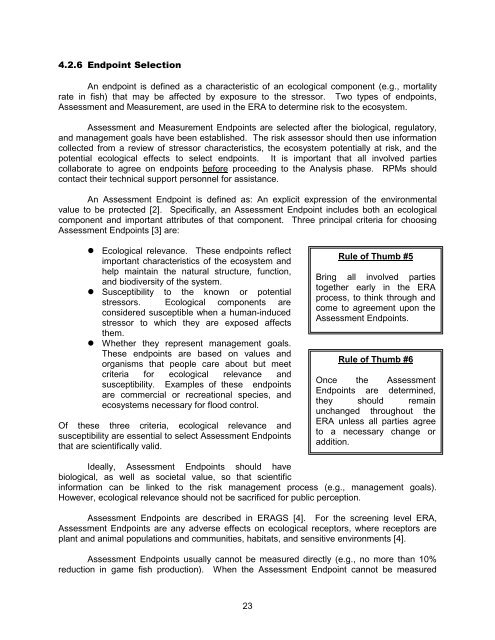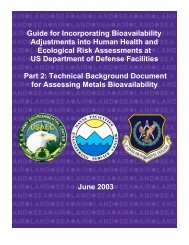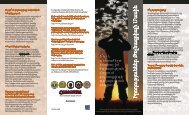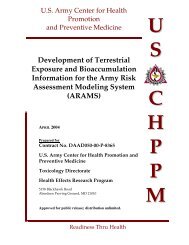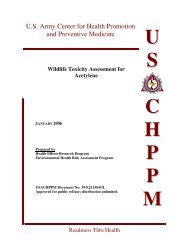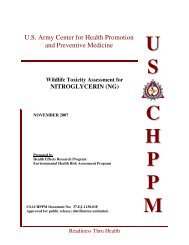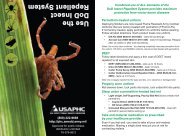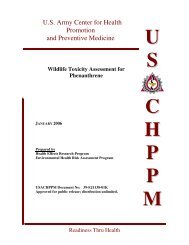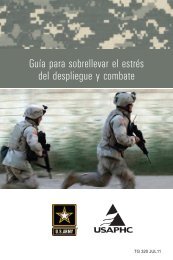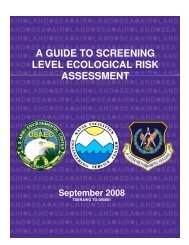Tri-Service Remedial Project Manager's Guide for Ecological Risk ...
Tri-Service Remedial Project Manager's Guide for Ecological Risk ...
Tri-Service Remedial Project Manager's Guide for Ecological Risk ...
Create successful ePaper yourself
Turn your PDF publications into a flip-book with our unique Google optimized e-Paper software.
(QGSRLQW6HOHFWLRQAn endpoint is defined as a characteristic of an ecological component (e.g., mortalityrate in fish) that may be affected by exposure to the stressor. Two types of endpoints,Assessment and Measurement, are used in the ERA to determine risk to the ecosystem.Assessment and Measurement Endpoints are selected after the biological, regulatory,and management goals have been established. The risk assessor should then use in<strong>for</strong>mationcollected from a review of stressor characteristics, the ecosystem potentially at risk, and thepotential ecological effects to select endpoints. It is important that all involved partiescollaborate to agree on endpoints be<strong>for</strong>e proceeding to the Analysis phase. RPMs shouldcontact their technical support personnel <strong>for</strong> assistance.An Assessment Endpoint is defined as: An explicit expression of the environmentalvalue to be protected [2]. Specifically, an Assessment Endpoint includes both an ecologicalcomponent and important attributes of that component. Three principal criteria <strong>for</strong> choosingAssessment Endpoints [3] are:l <strong>Ecological</strong> relevance. These endpoints reflectimportant characteristics of the ecosystem andhelp maintain the natural structure, function,and biodiversity of the system.l Susceptibility to the known or potentialstressors. <strong>Ecological</strong> components areconsidered susceptible when a human-inducedstressor to which they are exposed affectsthem.l Whether they represent management goals.These endpoints are based on values andorganisms that people care about but meetcriteria <strong>for</strong> ecological relevance andsusceptibility. Examples of these endpointsare commercial or recreational species, andecosystems necessary <strong>for</strong> flood control.Of these three criteria, ecological relevance andsusceptibility are essential to select Assessment Endpointsthat are scientifically valid.Rule of Thumb #5Bring all involved partiestogether early in the ERAprocess, to think through andcome to agreement upon theAssessment Endpoints.Rule of Thumb #6Once the AssessmentEndpoints are determined,they should remainunchanged throughout theERA unless all parties agreeto a necessary change oraddition.Ideally, Assessment Endpoints should havebiological, as well as societal value, so that scientificin<strong>for</strong>mation can be linked to the risk management process (e.g., management goals).However, ecological relevance should not be sacrificed <strong>for</strong> public perception.Assessment Endpoints are described in ERAGS [4]. For the screening level ERA,Assessment Endpoints are any adverse effects on ecological receptors, where receptors areplant and animal populations and communities, habitats, and sensitive environments [4].Assessment Endpoints usually cannot be measured directly (e.g., no more than 10%reduction in game fish production). When the Assessment Endpoint cannot be measured23


